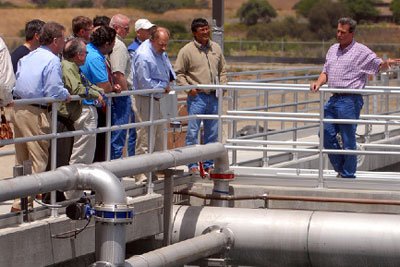
As water in California becomes an increasingly precious resource, South County authorities remain committed to expanding the availability of recycled wastewater for the most prolific consumers of the life-sustaining element.
Though all of the currently planned upgrades to the system – which are part of the 2004 South County Recycled Water Master Plan and include about 14,000 feet of new distribution pipes over the next three years – will take place in the City of Gilroy due to the proximity of existing facilities, more recycled water benefits the region as a whole because it takes some of the environmental and financial burden off the South County groundwater basin, proponents say.
At times like now with a drought and with costs to import groundwater from other parts of the state going up, recycled water use is a “win-win.”
“We draw the water from essentially the same source, whether it’s from the aquifer or introduced into the aquifer through percolation ponds,” said Morgan Hill Vice Mayor Gordon Siebert, who served last year as chair of the joint-powers South County Regional Wastewater Authority board of directors. “It’s kind of like solar energy – if you can take advantage of the sun from your rooftop then you don’t have to pay for fossil fuels.”
The City of Gilroy, in a long-term agreement with Morgan Hill and SCVWD, operates the South County wastewater treatment and recycled water production plant on Southside Drive.
It is one of four facilities in Santa Clara County that reclaim and purify wastewater through a multi-level treatment process, and it accounts for 11 percent of the SCVWD’s annual supply of recycled water, according to SCVWD staff. The Gilroy facility recycles about 24 percent of the 8,000 acre-feet of wastewater that travels through the plant from Gilroy and Morgan Hill – a vastly higher reclamation rate than the three other water recycling facilities in San Jose, Sunnyvale and Palo Alto.
An acre-foot of drinking water is enough to supply a family of five for two years.
SCVWD Director Dennis Kennedy said the South County facility is poised to see its production of recycled water only increase with the expansions proposed over the next few years.
“This has been a long standing goal of the Water District – to expand our recycled water to at least 10 percent of the County’s demand (for all types of water) by 2025,” Kennedy said. “We’re going to really see a demand for that water.”
An ongoing expansion is already in the works, and the City of Morgan Hill has committed about $8 million in Redevelopment bond proceeds – on top of $6 million spent since 2008 – to that effort.
Expanding recycled water supplies to Morgan Hill, where the sewer system is already tied onto the Gilroy wastewater plant, is not currently part of the recycled water master plan and is cost prohibitive for the foreseeable future, according to SCVWD staff. However, at the next long-term plan revision in 2015, they will look at the possibility of developing an intermediate treatment plant in Morgan Hill that could process the less dirty wastewater for recycled use.
“In order to get it to Morgan Hill (now) you would have to pump it uphill,” Siebert said. “If we could develop a facility locally, that could be cheaper because we wouldn’t have as large distribution costs.”
Non-potable recycled water is “near distilled quality” according to the SCVWD website, but it has little use for residential purposes. In Gilroy, only eight customers are tied onto the recycled water distribution system, but demand is continually on the rise, according to SCVWD staff.
Suitable only for certain agricultural, industrial and municipal uses – as well as fire suppression – recycled water is currently utilized in Gilroy by both the City’s golf course and the Eagle Ridge Golf Course, the Calpine electricity facility, two City parks, a business park and Obata farms in south Gilroy. The biggest user of recycled water is the plant itself, where it is used in the treatment process and the cleaning and cooling of equipment among other operational tasks, according to Gilroy Public Works Director Rick Smelser. All together, these customers use about 2,200 acre-feet of recycled water per year.
The commitment by South County officials to the long-term expansion of recycled water includes the coming installation of 14,000 feet of recycled water pipeline in Gilroy to serve future customers and expand the capacity for existing customers, according to SCVWD staff.
Construction on segments of this expansion are scheduled to begin as soon as this summer, with about half the new lines expected to be online by the end of 2014. Specifically, the City of Gilroy and SCVWD have been working with residential developers such as KB Homes and Glen Loma Ranch to install the infrastructure through or near their projects before they start building houses.
On the SCVWD’s board of directors meeting agenda for Tuesday is an update on the South County recycled water master plan, and an allocation of $3 million to Gilroy for reimbursement of costs associated with a new 30-inch recycled water pipeline to be built along West Luchessa Avenue adjacent to KB Homes’ proposed 237-unit Oak Place development.
“If you put the lines in now, you’re far ahead of the game. If you start from scratch, you’re going to have to dig up streets,” said Gilroy Mayor Don Gage, who also serves on the SCRWA board of directors. “It’s a win-win. There’s no new sources of water, and we’re not getting any rain here.”
While the residential developers will be participating in the construction of new recycled water pipelines, they are unlikely to use the water themselves, explained SCVWD Water Supply Unit Manager Joan Maher. Rather, the pipes will bypass those projects and be situated to serve future customers such as Gilroy Gardens and Western Tree Nursery.
At $18 per acre-foot of agricultural groundwater, farmers still have to pay their own costs to pump the water from the aquifer and pressurize it for irrigation and other uses, Gilroy farmer Thomas Obata explained. Recycled water on the other hand – at $42 per acre foot – is already pressurized in pipes that run close to the surface of the ground.
“It’s saving me money because this reclaimed water is under 90 pounds of pressure, so I can tap into the turnouts or valves, (whereas) if I had to pressurize my water it would cost me either an electric booster pump or diesel booster pump to run sprinklers,” Obata said. “So it’s saving me in PG&E and diesel costs.”
On top of that, Obata is enamored with the “sustainability” factor of recycled water, which helps to preserve groundwater supplies. He has been using recycled water on about half of his 1,300 acres of row crops in south Gilroy for “at least” 15 years – ever since it became available. Obata grows bell peppers, tomatoes, lettuce, broccoli and cabbage.












